ESP Oldsmobile Achieva 1995 s User Guide
[x] Cancel search | Manufacturer: OLDSMOBILE, Model Year: 1995, Model line: Achieva, Model: Oldsmobile Achieva 1995Pages: 340, PDF Size: 16.99 MB
Page 182 of 340
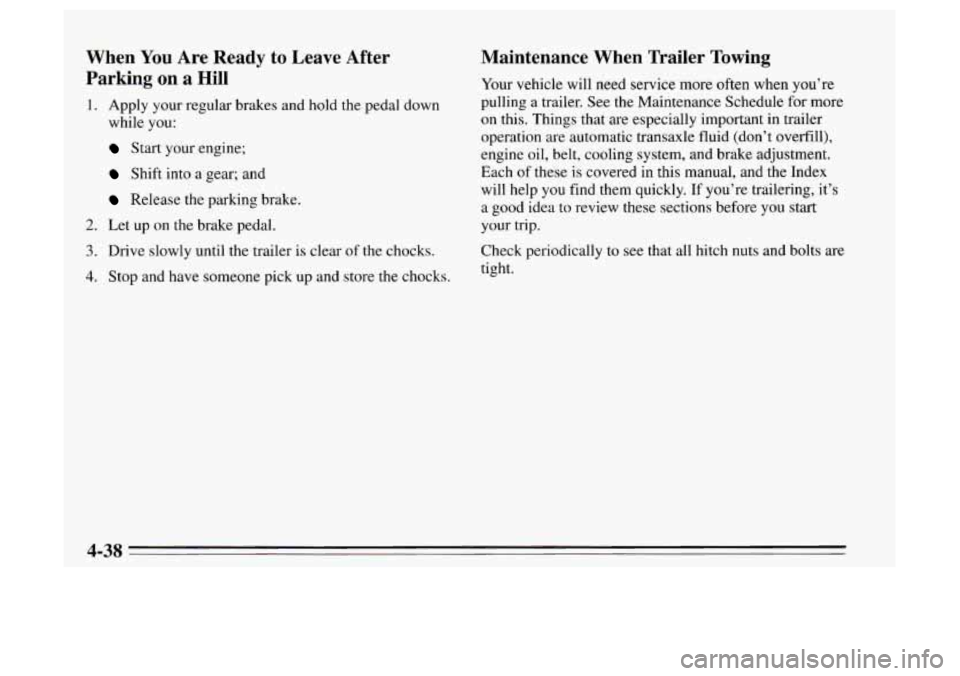
When You Are Ready to Leave After
Parking on a
Hill
1. Apply your regular brakes and hold the pedal down
while
you:
Start your engine;
Shift into a gear; and
Release the parking brake.
2. Let up on the brake pedal.
3. Drive slowly until the trailer is clear of the chocks.
4. Stop and have someone pick up and store the chocks.
Maintenance When Trailer Towing
Your vehicle will need service more often when you’re
pulling a trailer. See the Maintenance Schedule for more
on this. Things that are especially important in trailer
operation are automatic transaxle fluid (don’t overfill),
engine
oil, belt, cooling system, and brake adjustment.
Each
of these is covered in this manual, and the Index
will help
you find them quickly. If you’re trailering, it’s
a
good idea to review these sections before you start
your trip.
Check periodically to see that all hitch nuts and bolts are
tight.
4-38
-
Page 202 of 340
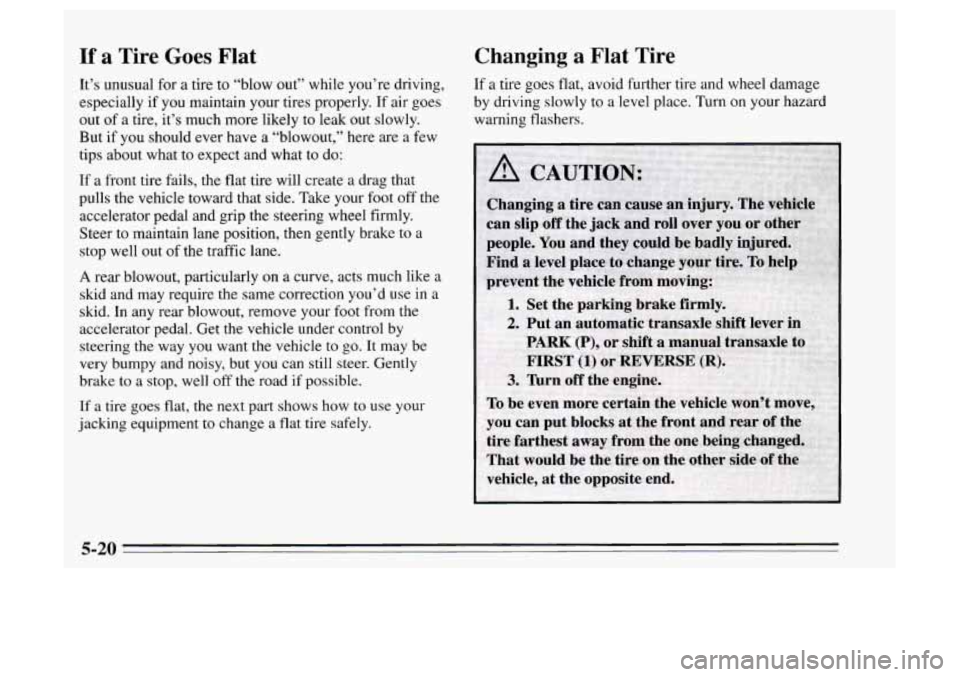
If a Tire Goes Flat
It’s unusual for a tire to “blow out” while you’re driving,
especially if you maintain your tires properly. If air goes
out of a tire, it’s much more likely to leak out slowly.
But if you should ever have a “blowout,” here are a few
tips about what
to expect and what to do:
If a front tire fails, the flat tire will create a drag that
pulls the vehicle toward that side. Take your foot off the
accelerator pedal and grip the steering wheel firmly.
Steer to maintain lane position, then gently brake to a
stop well out of the traffic lane.
A rear blowout, particularly on a curve, acts much like a
skid and may require the same correction you’d use
in a
skid. In any rear blowout, remove your foot from the
accelerator pedal. Get the vehicle under control by
steering the way you want
the vehicle to go. It may be
very bumpy and noisy, but you can still steer. Gently
brake to a stop, well off the road if possible.
If a tire goes flat, the next part shows how
to use your
jacking equipment to change a flat tire safely.
Changing a Flat Tire
If a tire goes flat, avoid further tire and wheel damage
by driving slowly to a level place. Turn on your hazard
warning flashers.
5-20
-
Page 213 of 340
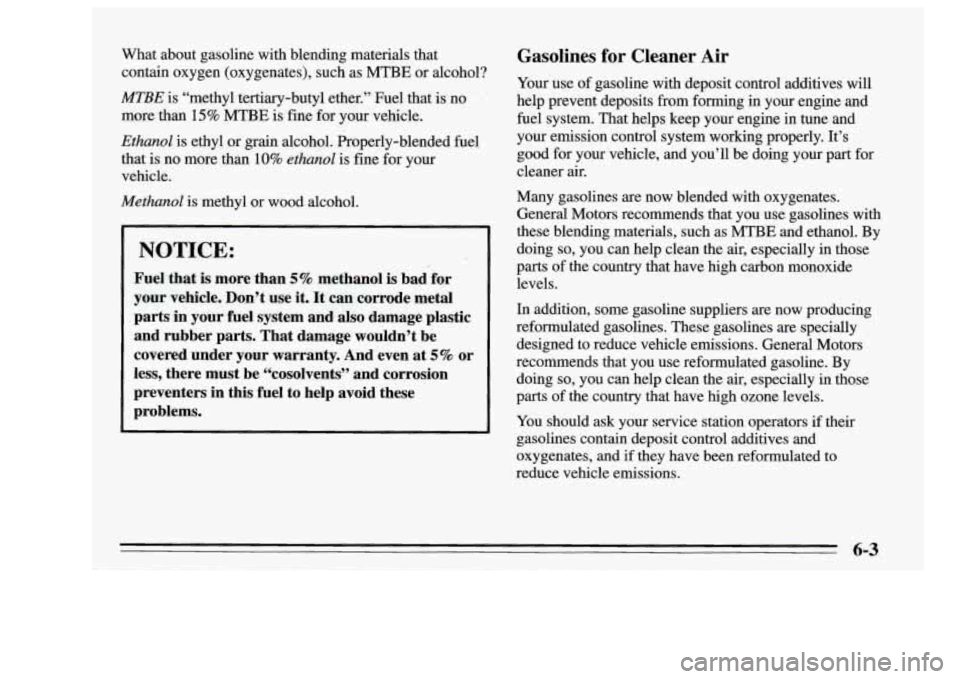
What about gasoline with blending materials that contain oxygen (oxygenates), such as MTBE or alcohol?
MTBE is “methyl tertiary-butyl ether.” Fuel that is no
more than
15% MTBE is fine for your vehicle.
Ethanol is ethyl or grain alcohol. Properly-blended fuel
that is no more than
10% ethanol is fine for your
vehicle.
Methanol is methyl or wood alcohol.
I I
I NOTICE:
Fuel that is more than 5% methanol is bad for
your vehicle. Don’t use it. It can corrode metal
parts in your fuel system and
also damage plastic
and rubber parts. That damage wouldn’t be
covered under your warranty. And even at
5% or
less, there must be “cosolvents” and corrosion
preventers in this fuel to help avoid these
problems.
Gasolines for Cleaner Air
Your use of gasoline with deposit control additives will
help prevent deposits from forming in your engine and
fuel system. That helps keep your engine in tune and
your emission control system working properly. It’s
good for your vehicle, and you’ll be doing your part for
cleaner
air.
Many gasolines are now blended with oxygenates. General Motors recommends that you use gasolines with
these blending materials, such as MTBE and ethanol. By doing
so, you can help clean the air, especially in those
parts of the country that have high carbon monoxide
levels.
In addition, some gasoline suppliers are now producing
reformulated gasolines. These gasolines
are specially
designed to reduce vehicle emissions. General Motors
recommends that you use reformulated gasoline. By doing so, you can help clean the air, especially in those
parts of the country that have high ozone levels.
You should ask your service station operators
if their
gasolines contain deposit control additives and
oxygenates, and
if they have been reformulated to
reduce vehicle emissions.
6-3
Page 227 of 340
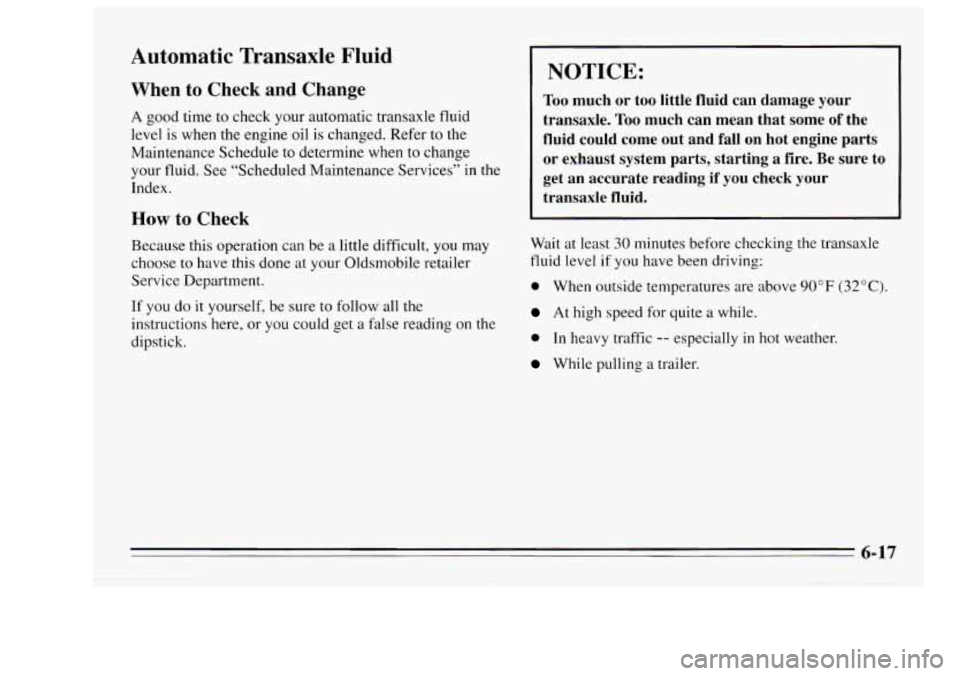
Automatic Transaxle Fluid
When to Check and Change
A good time to check your automatic transaxle fluid
level
is when the engine oil is changed. Refer to the
Maintenance Schedule to determine when to change
your fluid. See “Scheduled Maintenance Services’’ in the
Index.
How to Check
Because this operation can be a little difficult, you may
choose
to have this done at your Oldsmobile retailer
Service Department.
If you do it yourself, be sure to follow all the
instructions here, or you could get a false reading on the
dipstick.
NOTICE:
Too much or too little fluid can damage your
transaxle.
Too much can mean that some of the
fluid could come out and fall on hot engine parts or exhaust system parts, starting a fire. Be sure to get an accurate reading if you check your
transaxle fluid.
Wait at least 30 minutes before checking the transaxle
fluid level if you have been driving:
0 When outside temperatures are above 90 OF (32 O C).
At high speed for quite a while.
0 In heavy traffic -- especially in hot weather.
While pulling a trailer.
6-17
Page 229 of 340
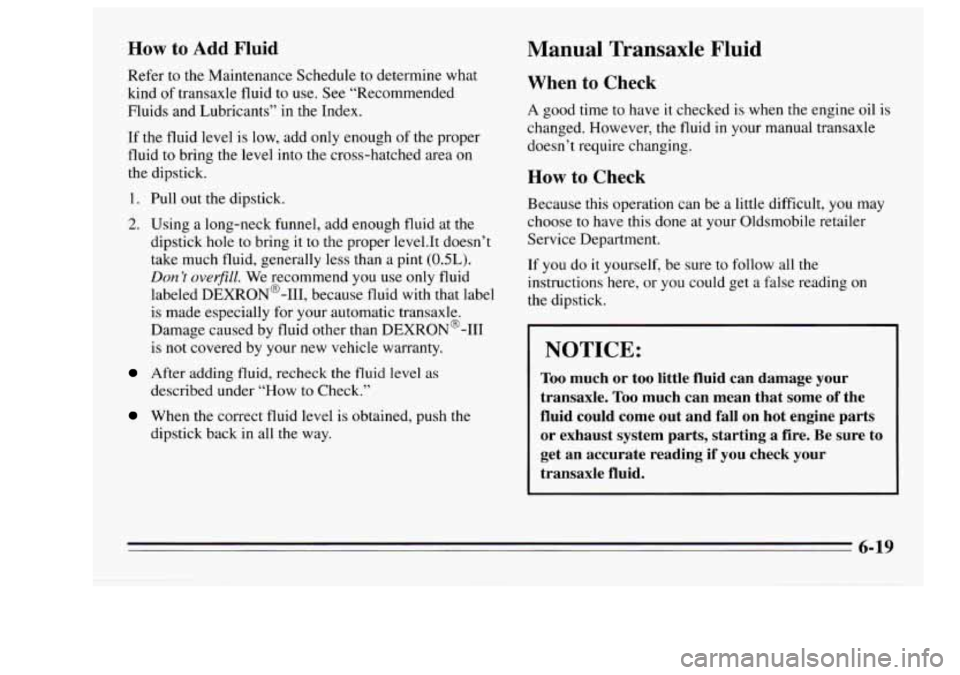
How to Add Fluid
Refer to the Maintenance Schedule to determine what
kind of transaxle fluid
to use. See “Recommended
Fluids and Lubricants” in the Index.
If the fluid level
is low, add only enough of the proper
fluid to bring the level into the cross-hatched area on
the dipstick.
1. Pull out the dipstick.
2. Using a long-neck funnel, add enough fluid at the
dipstick hole to bring it
to the proper 1evel.It doesn’t
take much fluid, generally less than a pint
(0.5L).
Don’t overfill. We recommend you use only fluid
labeled DEXRON@-111, because fluid with that label
is made especially for your automatic transaxle.
Damage caused by fluid other than DEXRON@-I11
is not covered by your new vehicle warranty.
After adding fluid, recheck the fluid level as
described under “How to Check.”
When the correct fluid level is obtained, push the
dipstick back in all the way.
Manual Transaxle Fluid
When to Check
A good time to have it checked is when the engine oil is
changed. However, the fluid in your manual transaxle
doesn’t require changing.
How to Check
Because this operation can be a little difficult, you may
choose to have this done at your Oldsmobile retailer
Service Department.
If you
do it yourself, be sure to follow all the
instructions here, or you could get
a false reading on
the dipstick.
NOTICE:
Too much or too little fluid can damage your
transaxle.
Too much can mean that some of the
fluid could come out and fall on hot engine parts
or exhaust system parts, starting a fire. Be sure to
get an accurate reading if you check your
transaxle fluid.
6-19
Page 244 of 340
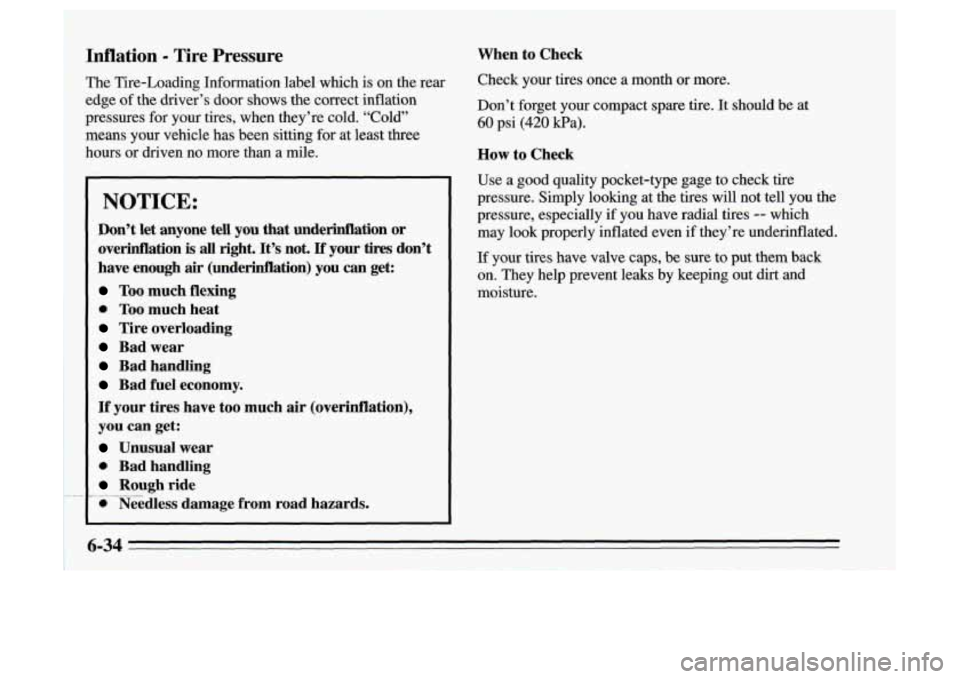
Inflation - Tire Pressure
The Tire-Loading Information label which is on the rear
edge
of the driver’s door shows the correct inflation
pressures for your tires, when they’re cold. “Cold”
means your vehicle has been sitting for at least
three
?--., hours TI-< 01 &iv_eu~o more than.a.mile.
NOTICE:
Don’t let anyone tell you that underinflation or
overinflation
is all right. It’s not. If your tires don’t
have enough
air (underinflation) you can get:
Too much flexing
0 Too much heat
Tire overloading
Bad wear
Bad handling
Bad fuel economy.
If your tires have too much air (overinflation),
you can get:
Unusual wear
0 Bad handling
Rough ride
0 Needless damage from road hazards.
___..
When to Check
Check your tires once a month or more.
Don’t forget your compact spare tire.
It should be at
60 psi (420 Wa).
How to Check
Use a good quality pocket-type gage to check tire
pressure. Simply looking at the tires will not tell you the
pressure, especially if you have radial tires
-- which
may look properly inflated even
if they’re underinflated.
If your tires have valve caps, be sure to put them back
on. They help prevent leaks by keeping out dirt and
moisture.
6-34
Page 248 of 340
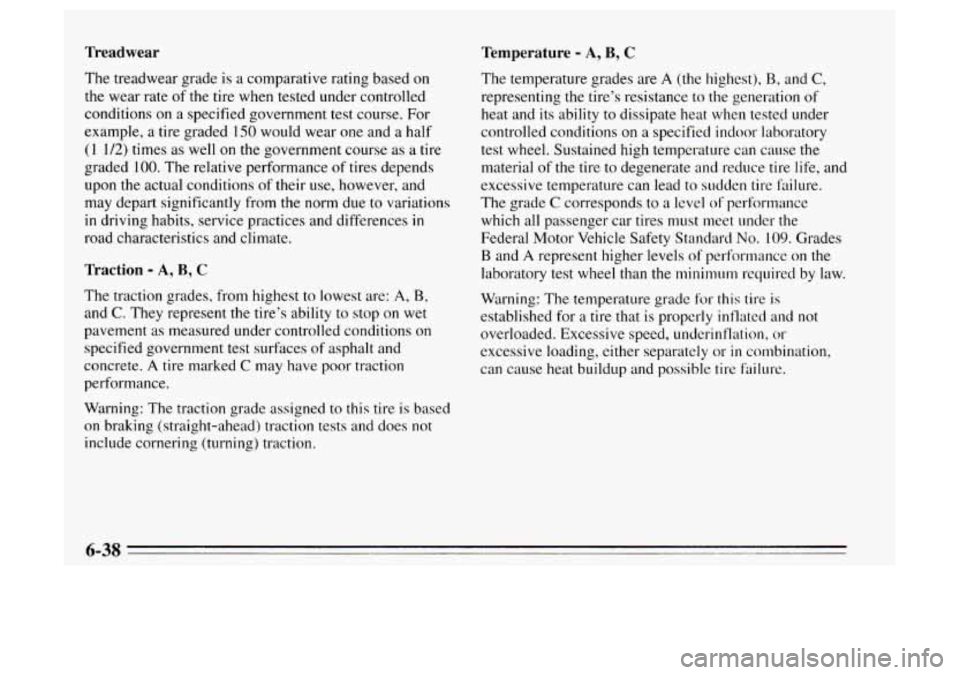
Treadwear Temperature - A, B, C
The treadwear grade is a comparative rating based on
the wear rate of the tire when tested under controlled
conditions on
a specified government test course. For
example, a tire graded
150 would wear one and a half
(1 1/2) times as well on the government course as a tire
graded 100. The relative performance
of tires depends
upon the actual conditions of their use, however, and
may depart significantly from the norm due
to variations
in driving habits, service practices and differences in
road characteristics and climate.
Traction - A, B, C
The traction grades, from highest to lowest are: A, B,
and C. They represent the tire’s ability to stop on wet
pavement as measured under controlled conditions on
specified government test surfaces of asphalt and
concrete.
A tire marked C may have poor traction
performance.
Warning: The traction grade assigned to this
tire is based
on braking (straight-ahead) traction tests and does not
include cornering (turning) traction. The
temperature grades are
A (the highest), B, and C,
representing the tire’s resistance to the generation of
heat and its ability to dissipate heat when tested under
controlled conditions on a specified indoor laboratory
test wheel. Sustained high temperature can cause the
material of the tire to degenerate and reduce tire life, and
excessive temperature can lead to sudden tire failure.
The grade
C corresponds to a level of performance
which all passenger car tires must meet under the
Federal Motor Vehicle Safety Standard
No. 109. Grades
B and A represent higher levels of performance on the
laboratory test wheel than the
ninimum required by law.
Warning:
The temperature grade for this tire is
established for a tire that is properly inflated and not
overloaded. Excessive speed, underinflation, or
excessive loading, either separately or
in combination,
can cause heat buildup and possible tire failure.
6-38
Page 249 of 340
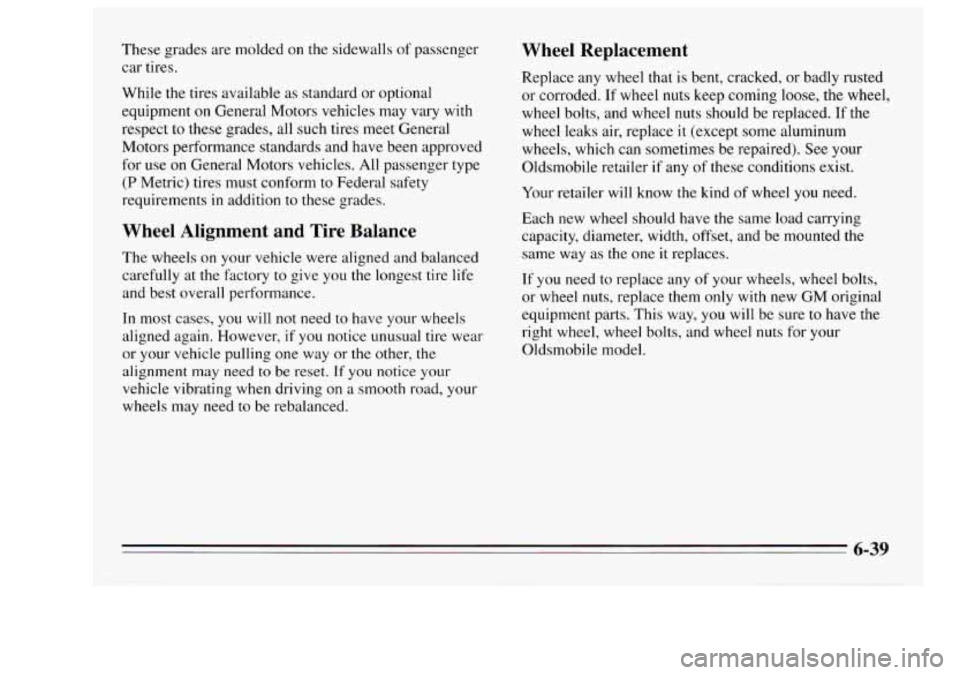
These grades are molded on the sidewalls of passenger
car tires.
While the tires available
as standard or optional
equipment
on General Motors vehicles may vary with
respect to these grades, all such tires meet General
Motors performance standards and have been approved
for use
on General Motors vehicles. All passenger type
(P Metric) tires must conform to Federal safety
requirements
in addition to these grades.
Wheel Alignment and Tire Balance
The wheels on your vehicle were aligned and balanced
carefully at the factory to give you the longest tire life
and best overall performance.
In most cases,
you will not need to have your wheels
aligned again. However,
if you notice unusual tire wear
or your vehicle pulling one way
or the other, the
alignment may need to be reset.
If you notice your
vehicle vibrating when driving on
a smooth road, your
wheels may need to be rebalanced.
Wheel Replacement
Replace any wheel that is bent, cracked, or badly rusted
or corroded.
If wheel nuts keep coming loose, the wheel,
wheel bolts, and wheel nuts should be replaced.
If the
wheel leaks air, replace it (except some aluminum
wheels, which can sometimes be repaired). See your
Oldsmobile retailer
if any of these conditions exist.
Your retailer will know the kind of wheel you need.
Each new wheel should have
the same load carrying
capacity, diameter, width, offset, and be mounted the
same way
as the one it replaces.
If you need to replace any of your wheels, wheel bolts,
or wheel nuts, replace them only with new GM original
equipment parts. This way,
you will be sure to have the
right wheel, wheel bolts, and wheel nuts for your
Oldsmobile model.
6-39
-
Page 315 of 340

Section 8 Customer Assistance Information
111
I
Here you will find out how to contact Oldsmobile if you
need assistance. This section includes information on:
The Customer Satisfaction Procedure, Customer
Assistance for Hearing or Speech Impaired,
BBB Auto
Line
-- Alternative Dispute Resolution Program,
Reporting Safety Defects, Roadside Assistance and
Service and Owner Publications.
Customer Satisfaction Procedure
Your satisfaction and goodwill are important to your
retailer and Oldsmobile. Normally, any concern
with the
sales transaction or the operation of your vehicle
will be
resolved by your retailer’s Sales or Service
Departments. Sometimes, however, despite the best
intentions
of all concerned, Illisunderstandings can
occur.
If your concern has not been resolved to your
satisfaction, the following steps should be taken:
STEP ONE -- Discuss your concern with a member of
your retail
fxility management. Normally, concerns can
be quickly resolved at that level.
If the matter has
already been reviewed
with the Sales, Service. or Parts Manager, contact the
owner of the retail facility or the
General Manager.
STEP TWO -- If after contacting a member of the retail
facility management,
it appears your concern cannot be
resolved by the retail facility without further help,
contact the Oldsmobile Customer Assistance Network
by calling 1-800-442-6537.
In Canada, contact GM of
Canada Customer Assistance Center
in Oshawa by
calling 1-800-263-3777 (English) or 1-800-263-7854
(French).
In Mexico, call (525) 254-3777. In Puerto Rim, call
1-800-496-9992 (English) or
1 -800-496-W3
(Spanish). In the U.S. Virgin Islands, call
1-800-496-9994.
In other overseas locations, contact
GM North American Export Sales in Canada by calling
1-905644-4
1 12.
8-1
Page 329 of 340
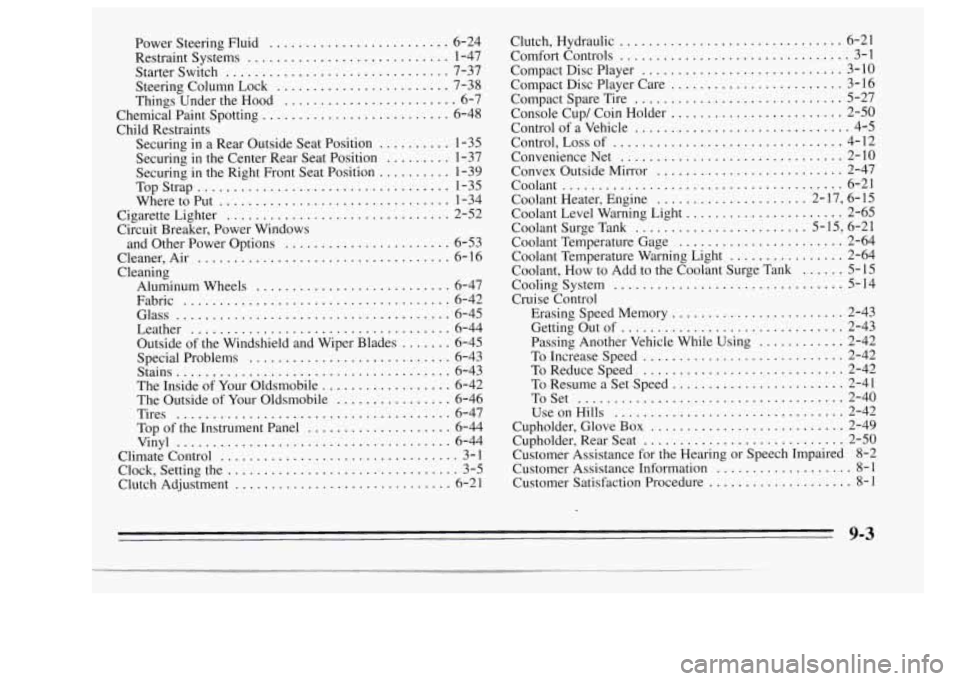
Power Steering Fluid ......................... 6-24
Restraint Systems
............................ 1-47
Starter Switch
............................... 7-37
Steering Column Lock
........................ 7-38
Things Under the Hood
........................ 6-7
Chemical Paint Spotting
.......................... 6-48
Child Restraints
Securing in a Rear Outside Seat Position
.......... 1-35
Securing in the Center Rear Seat Position
......... 1-37
Securing in the Right Front Seat Position
.......... 1-39
TopStrap
................................... 1-35
Cigarette Lighter
............................... 2-52
Circuit Breaker. Power Windows
and Other Power Options
....................... 6-53
WheretoPut
................................ 1-34
Cleaner. Air
................................... 6-16
Fabric
..................................... 6-42
Glass
...................................... 6-45
Leather
.................................... 6-44
Cleaning
Aluminum Wheels
........................... 6-47
Outside
of the Windshield and Wiper Blades ....... 6-45
Special Problems
............................ 6-43
Stains
...................................... 6-43
The Inside of Your Oldsmobile
.................. 6-42
The Outside
of Your Oldsmobile ................ 6-46
Tires
...................................... 6-47
Top
of the Instrument Panel .................... 6-44
Climate Control
................................. 3-1
Clock, Setting the
................................ 3-5
Clutch Adjustment .............................. 6-21
Vinyl
...................................... 6-44 Clutch.
Hydraulic
............................... 6-21
Comfort Controls
................................ 3-1
Compact Disc Player
............................ 3-10
Compact Disc Player Care
........................ 3-16
Compact Spare Tire
............................. 5-27
Console Cup/ Coin Holder
........................ 2-50
Control of a Vehicle
.............................. 4-5
Control. Loss of ................................ 4-12
Convenience Net
............................... 2-10
Convex Outside Mirror
.......................... 2-47
Coolant Heater. Engine
..................... 2- 17, 6- 15
Coolant Level Warning Light ...................... 2-65
Coolant Surge Tank
........................ 5- 15, 6-21
Coolant Temperature Gage
....................... 2-64
Coolant Temperature Warning Light
................ 2-64
Coolant. How to Add to the Coolant Surge Tank
...... 5-15
Cooling System ................................ 5-14
Cruise Control
Erasing Speed Memory
........................ 2-43
Getting Out
of ............................... 2-43
Passing Another Vehicle While Using
............ 2-42
To Increase Speed
............................ 2-42
To Resume a Set Speed
........................ 2-41
Coolant
....................................... 6-21
ToReduceSpeed
............................ 2-42
ToSet
..................................... 2-40
UseonHills
................................ 2-42
Cupholder. RearSeat
............................ 2-50
Cupholder, Glove
Box
........................... 2-49
Customer Assistance for the Hearing or Speech Impaired
8-2
Customer Assistance Information ................... 8-1
Customer Satisfaction Procedure
.................... 8-1
9-3